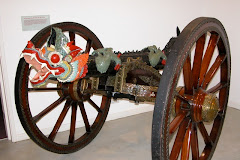There are two basic types of explosive: low explosives and high explosives. Most explosives detonate rather than burn. A detonation is a very rapid chemical reaction using oxygen that is contained in the material rather than in the air. In a detonation, the chemical reaction releases gases that rapidly expand and give off energy as they become hot, creating a pressure wave, or 'blast'.
However, low explosives tend to burn, giving off great heat and intense light, rather than detonate. This is known as 'deflagration'. Because they burn at a slower rate, this creates less pressure than high explosives and they are often used as propellants in guns and rockets: in other words, they provide the 'pushing' power that drives a rocket or sends the shell out of a gun.
From the time of its discovery until the mid-19th Century, black powder - or gun powder as it was usually known - was the most common explosive used throughout the world, and was used both as a propellant and (by enclosing it tightly in a confined space) to produce a detonation. However, it produced a lot of smoke, became ineffective when damp (hence the expression "Keep your powder dry!") and was dangerous to use - all factors that counted against it on the battlefield. Today black powder is still used for fireworks, special effects and other specialized work, but it has been replaced in warfare by more effective smokeless propellants and higher powered, yet safer, explosives.
It's worth spending a moment on how a propellant works in a gun because it was usually propellant improvements over the years that drove changes in gun design.
Gunpowder is a mixture of potassium nitrate (also known as saltpetre), charcoal and sulphur in a ratio of 15:3:2. The mixture varied over the years, but this became the generally accepted best mixture for guns. When a charge of gunpowder was placed in the chamber at the rear of a cannon and a cannonball loaded in front of it, the powder was in effect in a closed container. There was a vent hole immediately above the charge through which a flame was introduced to 'fire' the gun, and there was a small amount of space around the cannonball ("windage"), but there was not enough of these spaces to allow the propellant gases to escape, once the gunpowder was alight. The rapid burning and the release of huge quantities of gas raised the pressure in the chamber of the gun, and as the pressure increased, so did the rate of burning. Something had to give or there would be an explosion!
What gave, of course, was the cannonball. It was pushed at high speed along the barrel, accelerating all the way until it was ejected and sent off on its journey to the target. If the gun had a long barrel - like most cannons - it was accelerated for longer and therefore emerged at a higher speed than it would in a mortar, which all had much shorter barrels than cannons.
Much development went into making gunpowder burn faster, which increased the muzzle velocity, but in turn, this meant that the pressure at the chamber end of the gun became greater and required extra reinforcement. If you look at an early cannon, it is relatively slender compared with later guns, where the chamber end of the gun tends to be very much thicker than the muzzle end, due to the need for stronger, thicker walls to contain the pressure.
Subscribe to:
Post Comments (Atom)




No comments:
Post a Comment